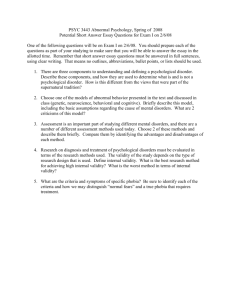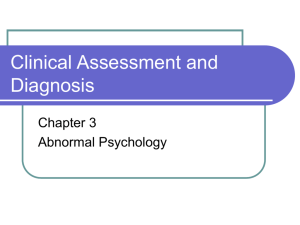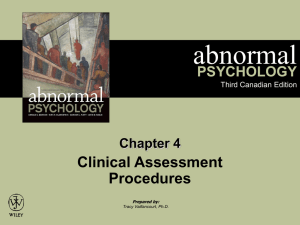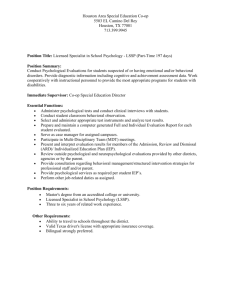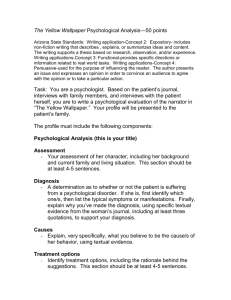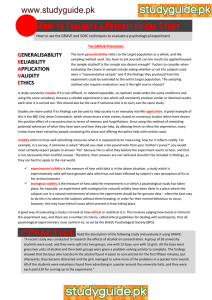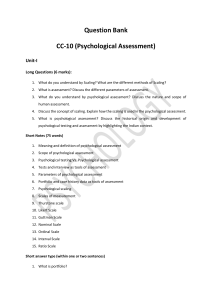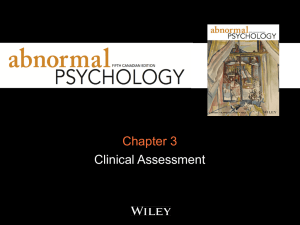Huffman PowerPoint Slides - HomePage Server for UT Psychology
advertisement
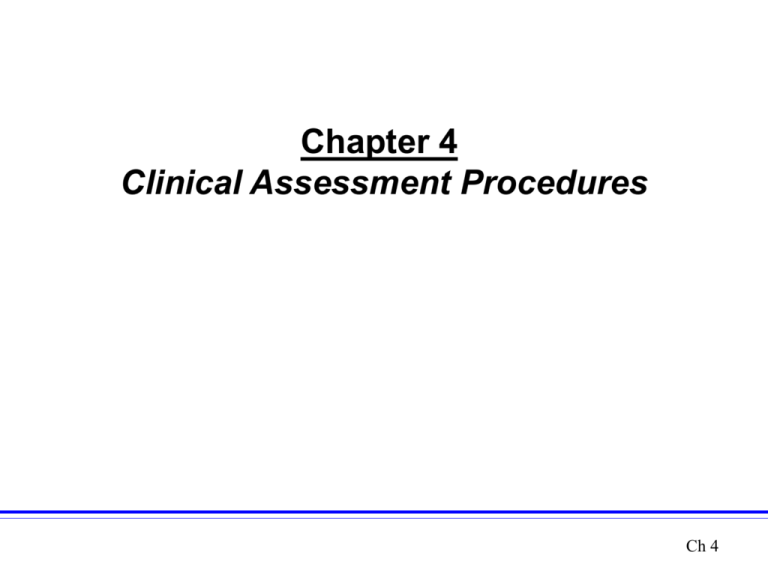
Chapter 4 Clinical Assessment Procedures Ch 4 Reliability • Reliability refers to consistency of measurement • Types of reliability: – Interrater reliability refers to the degree of agreement between 2 observers – Test-retest reliability refers to the extent to which scores are similar for a person being observed twice or taking the same test twice – Internal consistency reliability examines whether the items on a test are related Ch 4.1 Validity • Validity assesses the extent to which a test or instrument fulfills its intended purpose – Some tests are designed to assess an inferred dimension referred to as a construct • “Anxiety” is an inferred construct – The validity of an instrument is constrained by the reliability of the instrument • Unreliable measures will not have good validity Ch 4.2 Forms of Validity • Content validity refers to whether a measure adequately samples the domain of interest • Criterion validity refers to whether a measure is associated in an expected way with another measure (the criterion) • Construct validity refers to whether a measure of a construct is supported by other measures of that construct Ch 4.3 Psychological Assessment • The goal of psychological assessment is to determine cognitive, emotional, personality and behavioral factors in psychopathology • The importance of standardization of assessment • Techniques of assessment include – – – – Clinical interviews Psychological tests Behavioral assessment procedures Cognitive assessment procedures Ch 4.4 Clinical Interviews • An interview is any interpersonal encounter in which language is used to gather information about a client – A clinical interviewer pays attention to how the client answers questions posed by the interviewer – Clinical interviews involve a degree of empathy for the problems of the client – Clinical interviews can be highly structured or very informal Ch 4.5 Psychological Tests • Psychological tests are standardized procedures designed to measure a person’s performance on a task or to assess his or her personality • Psychological tests include: – Personality inventories • Minnesota Multiphasic Personality Inventory – Projective personality tests • Rorschach Inkblot test – Intelligence tests Ch 4.6 Projective Tests • Projective tests provide ambiguous stimuli that are interpreted by the test subject according to unconscious needs/impulses – Rorschach Inkblot Test: person is asked to explain each of 10 ink blots (half of the blots are in color while half are black and white) – Thematic Apperception Test: person is shown a series of pictures and asked to explain the story behind each Ch 4.7 Intelligence Tests • Intelligence (IQ) tests can be used to – provide a standardized assessment of a person’s current mental abilities – diagnose learning disabilities – determine whether a person is mentally retarded – identify intellectually gifted children • IQ tests typically have good reliability and criterion validity Ch 4.8 Behavioral Assessment • Behavioral and cognitive assessments are made using the SORC system: – S (Stimuli): refers to the environmental situations that precede the problem – O (Organismic): refers to physiological and psychological factors operating “under the skin” – R (Overt Responses): what are the responses and are these a problem? – C (Consequent Variables): are there events that are punishing or reinforcing for the client? Ch 4.9 Behavioral Methods • Direct observation of behavior • Self-monitoring – Reactivity: behavior changes during monitoring • Interviews • Self-report inventories • Other procedures – Thought listing Ch 4.10 Neurochemical Assessment • The biological view is that neurotransmitters and receptors are key to understanding normal/abnormal behavior • Postmortem studies: brain is removed and chemical analyses are performed to – Determine specific amounts of transmitter in specific brain regions – Determine amount of transmitter metabolites • More metabolite suggests the presence of more transmitter in brain Ch 4.11 Human Brain Structure Figure 4.a Figure 4.b Ch 4.12 Neuropsychological Assessment • A Neuropsychologist is a psychologist who studies how brain damage alters the way we think, behave and feel • A neurologist studies brain diseases • Neuropsychological tests assess behavioral disturbances caused by brain dysfunction – Halstead-Reitan battery – Luria-Nebraska battery Ch 4.13 Psychophysiological Measurement • Psychophysiology is concerned with the bodily changes that accompany psychological events or a person’s psychological characteristics • Measures includes: – Heart rate (EKG) – Skin conductance (GSR) – Brain electrical activity (EEG) Ch 4.14 The Autonomic Nervous System Figure 4.c Ch 4.15 Cultural Bias in Assessment • Cultural bias can occur because of – language differences, differing views of competition, differing religious/spiritual views • Clinicians can avoid cultural bias by – making efforts to learn about the culture of the client – determining the client’s preferred language – ensuring that the client understands the assessment task – establishing a rapport with the client Ch 4.16 Is Human Behavior Consistent? • A key issue in clinical assessment is the extent to which human behavior is consistent/variable over time – Trait theory: people possess certain levels of characteristics that remain constant over time – Mischel: argued that traits are not important determinants of a person’s behavior • People are inconsistent across situations – “Big Five” (NEO-PI): Broad factors, consistent across situations, time, and most cultures Ch 4.17
